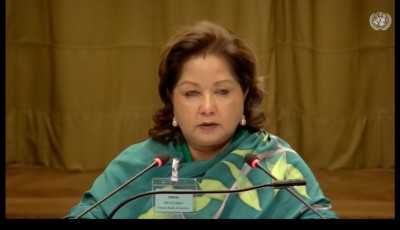Russia’s New Nuclear Doctrine: A Strategic Shift Amid Escalating Tensions
Experts warn that the Kremlin's revised nuclear doctrine is both provocative and ambiguous.

Russia's revised nuclear doctrine appears aimed at deterring deeper involvement of Ukraine's allies in the war by establishing ambiguous red lines, according to experts.
On the 1,000th day of the conflict, Moscow issued a stark warning following Ukraine’s use of longer-range U.S.-supplied missiles against Russian territory for the first time.
President Vladimir Putin responded by issuing a nuclear threat and signing a decree that lowers the threshold for using nuclear weapons, a move condemned as "irresponsible" by the White House, the UK, and the European Union.
Foreign Minister Sergei Lavrov accused Western nations of seeking to "escalate" the conflict after Washington authorized Ukraine to deploy ATACMS missiles, a long-standing request from Kyiv. Russian military analyst Vassily Kashin said the attack would not have been possible without Western involvement, including French and British Scalp/Storm Shadow missiles.
"From Russia's perspective, this constitutes a direct attack on Russian territory," Kashin told AFP, noting that similar weapons had been used in Crimea and Donbas, regions claimed by Russia but not recognized internationally as such.
Putin’s frequent nuclear threats since the invasion in 2022 now appear to be an effort to reinforce their credibility. The pro-Russian Telegram channel Rybar observed that "Russia's red lines are taken less and less seriously," reducing Moscow’s room for strategic maneuvering.
Lowering the Nuclear Threshold
Experts warn that the Kremlin's revised nuclear doctrine is both provocative and ambiguous. Maxim Starchak, a Russian nuclear policy specialist at Queen’s University in Canada, said the doctrine "lowers the threshold" for nuclear weapons use but leaves the scale of such threats unclear.
“Russia now links the possibility of nuclear weapon use to territorial threats, but the ambiguity around what constitutes such a threat adds to the uncertainty,” Starchak explained.
Adding to tensions, North Korean troops have reportedly been deployed to Russian territories, while Ukraine’s acquisition of U.S. missiles mark a significant escalation. Although these developments stop short of triggering nuclear action, they edge the conflict closer to a direct confrontation between Russia and NATO, Starchak noted.
Strategic Calculations
Pavel Podvig, an independent analyst based in Geneva, said the Kremlin is under pressure to achieve its goals quickly as increasing Western military support for Ukraine slows Russian progress.
“Russia seems determined to maintain its momentum, despite mounting challenges,” Podvig remarked.
Tatiana Stanovaya of the Carnegie Russia Eurasia Center suggested that Putin might view the current geopolitical landscape as a critical “in-between” moment. With the U.S. preparing for its presidential elections, Putin may anticipate a more favorable approach from a possible Trump administration, while emphasizing what he sees as the failures of Biden's policies.
As the war enters a more volatile phase, the international community remains on edge over the prospect of further escalation, whether through conventional warfare or the use of nuclear weapons.
(AFP Inputs)



















तपाईको प्रतिक्रिया दिनुहोस